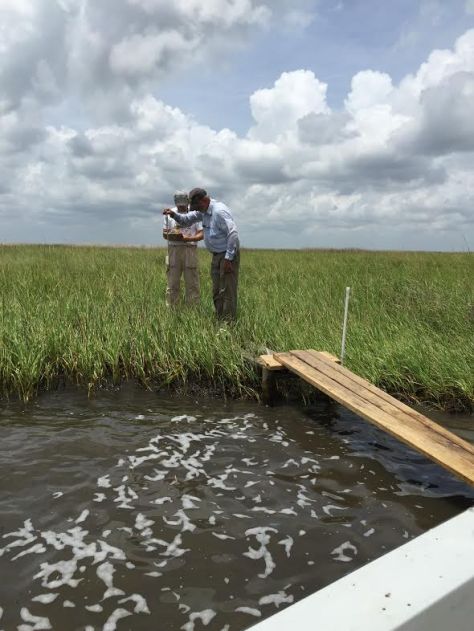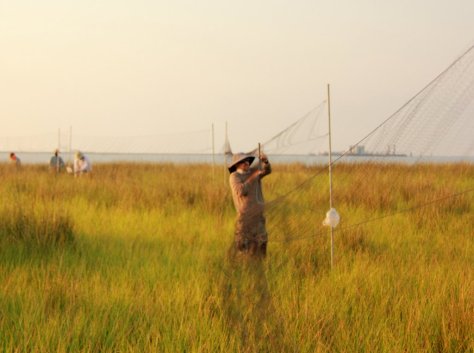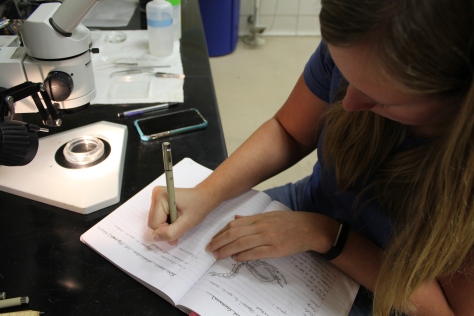The Coastal Waters Consortium, formed after the 2010 Deepwater Horizon oil spill in the Gulf of Mexico (GOM) and funded by the Gulf of Mexico Research Initiative (GoMRI), is a collection of scientists focused on the impacts of oil residues on coastal and shelf ecosystems. Now in its third round of funding, the CWC team is looking to the future and examining what has been learned.

CWC research was originally split into five subcategories based on the consortium’s goals and hypotheses: physical/chemical/sedimentary processes, biogeochemistry, invertebrate studies, vertebrate studies, and integrative studies. Individual scientists worked on projects in several categories based on their research specialties. Each project was designed to try and answer one or more of the following research questions:
- Where is the oil now and how has it changed since 2010?
- What are its impacts and how have these impacts evolved since 2010?
- Have parts of the ecosystem been resilient, recovered or compromised?
- How do the spill-related stressors interact with other stressors?
- What indicators of stress and recovery can be developed to manage future stressors?
- What data, tools or perspectives need to be applied or developed to improve our understanding?
These questions have been the foundation for the CWC’s work along the Gulf coast and have helped focus the efforts of each consortium member. As in all scientific inquiry, these original questions may not be fully answered by this team of scientists within this specific time frame. However, the research being conducted is laying the framework for future work and the continued recovery of the Gulf of Mexico.
Here is what’s been happening this year:
- Physical/Chemical/Sedimentary Processes
The Overton lab (LSU) continues to process samples for hydrocarbons (a component of petroleum and natural gas) as they study the fate and movement of carbon following the oil spill. Water and sediment samples are taken regularly from set locations on Bay Jimmy and Barataria Bay in order to check for the presence of oil residue within the ecosystem and “track” its movement. There remain pockets of fresh oil, mostly in crab burrows, but the chemical fingerprint of the original oil is mostly gone.

The Justić/Huang group uses numeric models to analyze, track, and predict the movement of oil, water and sediments based on wind and ocean current patterns. The group has two publications in for review that examine the varying effects of remote and local winds (i.e., large-scale wind systems, like storms, versus small-scale, more regular wind patterns) on water and oil transport. They previously examined the effectiveness of freshwater diversions as a tool for keeping the oil slick away from the coastal habitats.
Dr. Mariotti’s lab continues to develop and test models of marsh shoreline erosion in areas with oil exposure. A related manuscript has been submitted for review. Dr. Mariotti also contributed to the analysis of water and sediment samples that are tested for the presence of hydrocarbons.
- Biogeochemistry
Dr. Bernhard examined the abundance of comammox bacteria in GOM marsh sediment. Comammox is a microbe that plays a key role in nitrogen cycling by first converting ammonia to nitrite and then nitrite into nitrate. The study demonstrated that this microbe is plentiful in marsh sediment and may help explain the nitrogen cycling rates seen in southeastern Louisiana marshes.
The Roberts lab continues to work their way through a large quantity of samples that will contribute data to several scientific papers. Their studies include habitat preference by periwinkle snails, nutrient cycling in coastal marshes, plant responses to changes in salinity and chemical cycling, and oil’s impact on microbial communities. Early results of the periwinkle study suggest that snails prefer certain grasses over others, dead and aging leaves over live leaves, and that they spend more time on the plants during the day than at night.
-

Roberts Lab Research Assistant Logan McPherson collects pore water samples from the marsh at LUMCON. Photo Credit: LUMCON/Virginia Schutte
Dr. Giblin conducted a small-scale study of the effects of oil on the nitrogen cycle within New England marshes as a comparison to the studies conducted along the Gulf coast.
The Engel lab continues to process their samples in an ongoing examination of microbial genetics and the impact of oil exposure. These data are being used to monitor the recovery of microbial communities and identify changes in the larger food web.
- Invertebrate Studies
Dr. Hooper-Bui’s research examines the impact of oil on the insect and spider communities of coastal marshes. Initial reports indicated the insect and spider populations in marshes exposed to oil were not recovering as quickly as populations disturbed by hurricanes. This could indicate that these organisms would be good indicator species of marsh health and recovery.

- Vertebrate Studies
The Bird/Rat group of Taylor, Stauffer, and Woltmann worked with Olin, Polito, Husseneder, and Foil to organize a workshop to discuss the group’s food web data and how it will be analyzed. This collaboration brings together research from the Seaside Sparrow and Marsh Rice Rat study with other food web studies from within the consortium. Seaside Sparrows and Marsh Rice Rats have been identified as good indicator species in the marsh because they are year-round residents, easy to capture, and are found in high abundance.

Dr. Paruk continued the analysis of data from his Common Loon study looking for patterns and trends. Common Loons are another good indicator species as they are long-lived, return to the same feeding and breeding grounds, and are an apex predator within their food web. Paruk’s lab employs catch-and-release procedures to measure PAH levels within the population. PAHs, or polycyclic aromatic hydrocarbons, are carcinogenic compounds that can cause a range of health effects including liver damage, weight loss, immunosuppression, and gut damage. Long-term exposure and accumulation may impact reproduction and survival.

Dr. Martin is completing revisions for a manuscript on the feeding preferences of herbivorous invertebrates (grass shrimp and amphipods) on submerged vegetation grown in four concentrations of oil.
A Gulf wide sampling campaign for the group of Roberts, Fodrie, and Martin was cancelled due to Hurricanes Florence and Michael. The group is looking to reschedule for spring 2019.
- Integrative Studies
Several CWC synthesis activities are moving forward along with several cross-consortia syntheses. These allow for the sharing of data, collaborative analysis, and legacy project creation.
The marsh mesocosm project at the LUMCON Marine Center is in the initial phase of determining baseline conditions. Oiling experiments on the systems will take place in the spring. These mesocosms will integrate aspects of most of CWC’s research over the last seven years.

As we close out on 2018, all GoMRI-supported consortia and researchers are looking ahead to the annual Gulf of Mexico Oil Spill & Ecosystem Science (GoMOSES) Conference in New Orleans in February 2019. This an opportunity for everyone to share their work and discuss the state of the Gulf and the system-wide impacts of the Deepwater Horizon oil spill.





